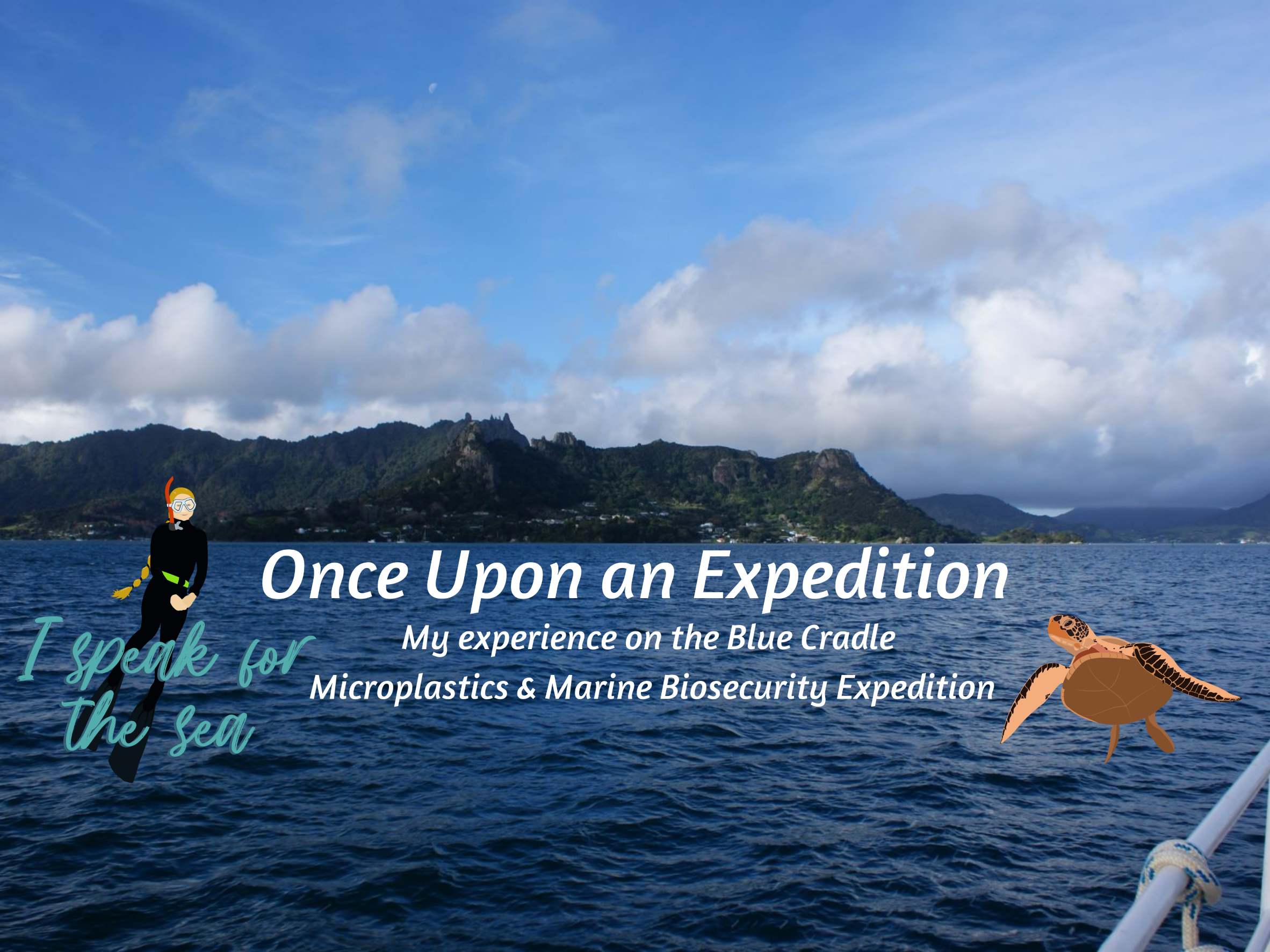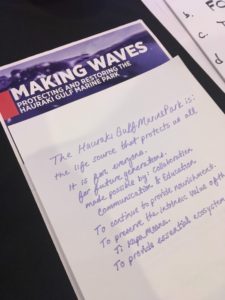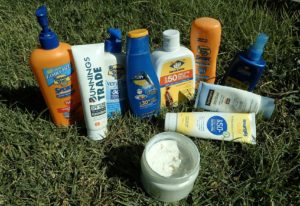What is an ‘Expedition’ anyway? If you look to the dictionary you find a few definitions, such as: a journey undertaken by a group of people with a particular purpose. It feels like the word ‘expedition’ can apply to all sorts of situations, but it also applies really well to this trip I was a part of – the Blue Cradle Microplastics and Marine Biosecurity Expedition. Much to my surprise, just over one week out from the expedition launch event, I was invited to join the Blue Cradle team on a short leg of their inaugural expedition aboard the S.V. Manawanui, a big steel yacht, sailing from Leigh to Whangarei on the 18th to the 21st of June. I could hardly believe I’d been offered the opportunity to participate in a research expedition collecting data and learning more about microplastics and biosecurity in the Hauraki Gulf – this is my story of the adventure.
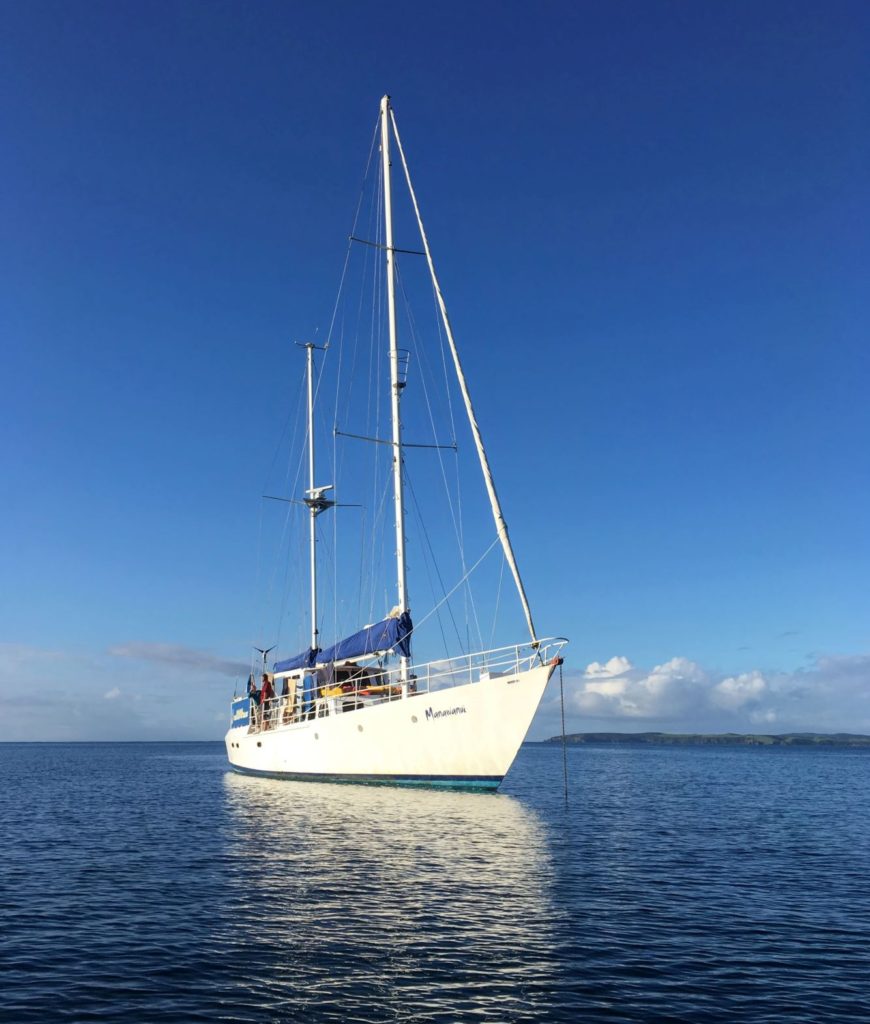
James Nikitine, founder of Blue Cradle, had been working towards bringing a group together to make this expedition happen for just over one year. This new not-for-profit aspires to participate in the scaling-up of the sustainable, regenerative blue economy through research, education, and by ensuring there’s good communication about these solutions. One avenue they are using to do that is through bringing researchers together to address complex issues of ecosystem resilience, anthropogenic pressures, and marine biodiversity characterization. I finally met James in person and introduced myself to a few of the crew at the launch event in Auckland on June 12th and started to really feel stoked to have the opportunity to join the team for a few days at the end of that week.
The adventure begins…
I met up with the Blue Cradle Expedition crew in Leigh, at the Marine Discovery Centre, for their public outreach event on the evening of Thursday 17th June. Earlier that day I was washing my SCUBA gear, literally just below the entrance to the Discovery Centre. I had just spent a good part of that day with other University of Auckland students, monitoring a kelp-regeneration study site a bit north of Leigh Harbour. My underwater tasks that day included recording algal cover and abundance of sea urchins and other invertebrates. I had an awesome day in the water and couldn’t be much more stoked to be headed away on a research expedition for a few days.
We settled into the discovery centre to hear a bit about Blue Cradle, learn about the expedition partners and the significance of the research on microplastics and non-indigenous marine species in the Hauraki Gulf. The main take home message for me that night was a reminder of how important it is to support the collection of data in order to have scientific evidence to support policy change. Efforts towards understanding the impact and the extent of plastic pollution in the Hauraki Gulf (and everywhere else!) has the power to support changing policies around our heavy reliance plastics and move us towards more sustainable alternatives.
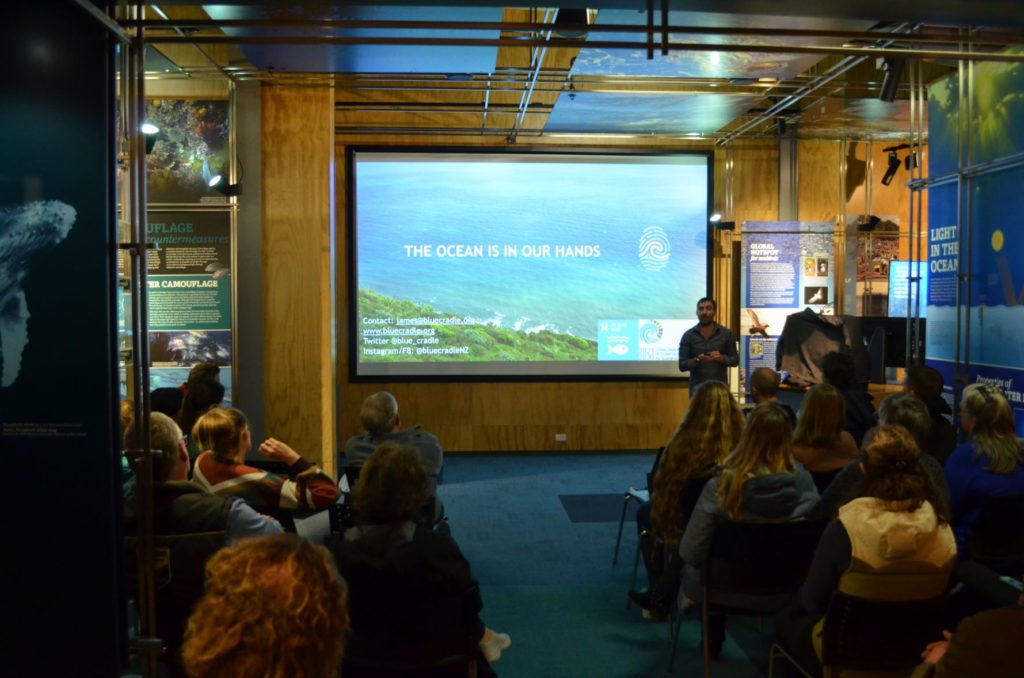
Later that night after the event, we all squeezed onto a dinghy to get over to the S.V. Manawanui anchored at the mouth of Leigh Harbour. I think there was 11 of us that squished in plus some laptop bags, my overnight bag, camera bag, and bulky bag of wet weather gear! That evening before bed I had some nice conversation with the team and heard a bit about how the expedition was going so far. The team had some rather rough and rainy weather at the start of the trip but as conditions improved they also ironed out their techniques and overall everything was going smoothly. The next day wasn’t going to be as per the original plan, it was decided that it would be wiser to play it safe and not try to circumnavigate Great Barrier Island, as there was some strong winds coming in soon. Strong winds were no good for sampling, nor would it be comfortable for anyone onboard. This did not come as a surprise to me since I had been keeping a close eye on the forecast as well and the weekend was looking quite windy!
I was exhausted from the busy week and I wanted to rest up for the adventure ahead so I eventually made my way to my bunk, up top in one of the rooms with four beds. While I’m not usually bothered by the height of the top bunk, I must say I prefer it when there is a ‘lee cloth’. One of my favourite parts about sleeping on boats is how a lee cloth makes you feel a little like you’re in a hammock and can’t roll out of bed. I didn’t fall asleep quickly but when I did I slept deeply – little did I know this first night onboard would be the best night’s sleep of the trip!
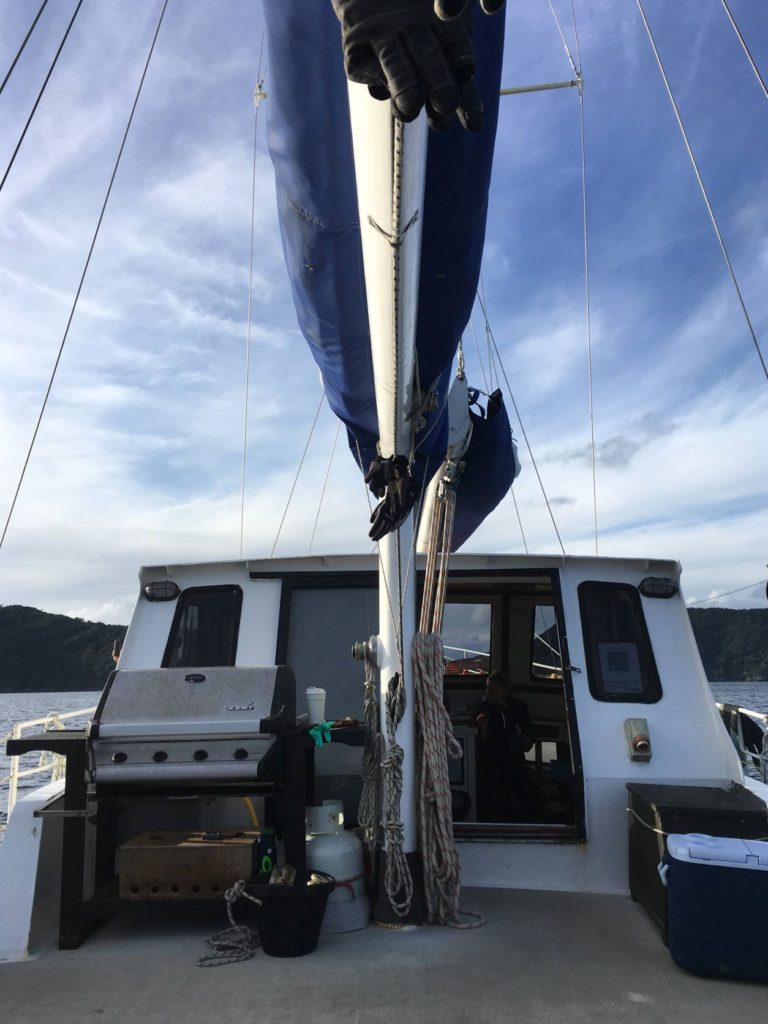
The cockpit of S.V. Manawanui. 
One of the aft bunk rooms aboard Manawanui prior to the trip- without all of our gear in it. Photo Credit: Ecocruz
Day 1: Leigh Harbour to Marsden Cove
I woke up to the familiar sound of a rumbling diesel engine just before 5 am, not long after, the squeaky anchor winch started pulled up the many metres of chain which held the 22 metre, two masted ketch at anchor in Leigh Harbour. While I stayed in my narrow but cozy bunk, captain Jochen Zaeschmar, got us underway to our first sampling site of the day. I fell back asleep for a bit after we were underway and amazingly I managed to wake up at precisely the right time to catch the sunrise – with no alarm – I woke up about 10 minutes past 7. There was just enough time for me to get dressed in warm clothes, put my contacts in, find my camera, and get on deck to capture some wicked images of the sky before sunrise.
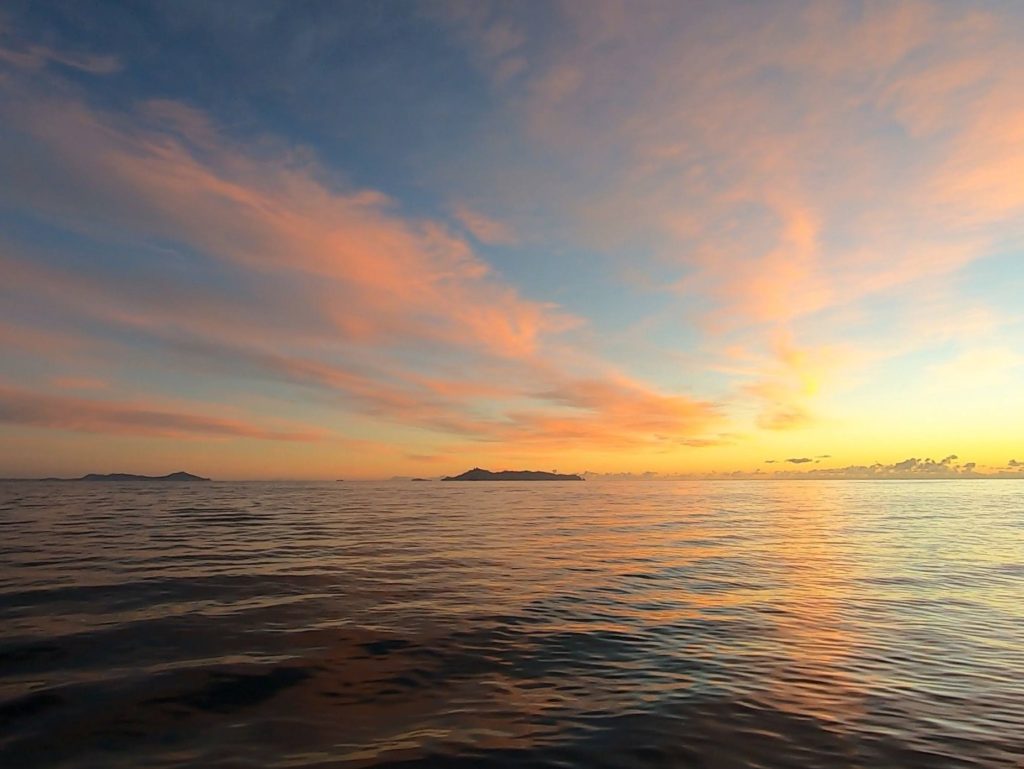
One of the main focuses of this voyage was to collect data to measure the occurrence and abundance of microplastics on the sea surface, research which was led by Aotearoa Impacts and Mitigation of Microplastics (AIM2) So, starting data collection just after the sun came up, we towed a manta trawl at several predetermined sites. On this trip we used a mini-size manta trawl (also known as ‘Manny’) for collecting sea surface microplastics. Microplastics are insidious tiny fragments of plastics less than 5 millimeters (0.2 inches), which includes microfibres and pre-production pellets (also known as primary microplastics). That also includes all the small pieces of degrading plastic (referred to as secondary microplastics). The reason I say insidious is because microplastics can absorb and concentrate pollutants like pesticides, and ingestion of those plastics by organisms presents the potential for accumulation of toxicity in the animals that eat it. This could affect species higher in the food chain as many of those toxins can gradually accumulate in a process known as bioaccumulation.
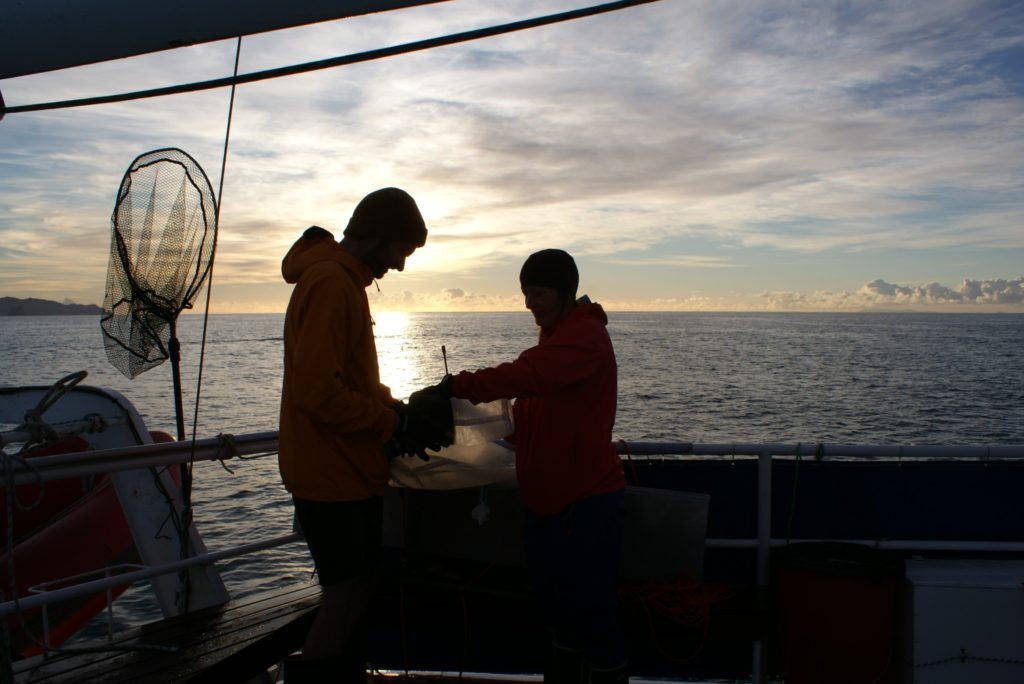
The net part of the manta trawl is constructed of a strong nylon collar with additional reinforcement along the length of the fine mesh net and a detachable filter bag at the cod end (narrow end) of the net – which collects the sample and is easily unscrewed for rinsing and sample retrieval. On this trip we towed ‘Manny’ the manta trawl for 15 minute sampling periods at specified sites where we also collected information on several other variables to strengthen the data and make it suitable for comparison. In order for us to make informed conclusions about the occurrence and abundance of microplastics we need to record environmental factors such as; wind speed, wind direction, sea state, barometric pressure, and temperature. The latitude and longitude are recorded to determine distance traveled, and a flowmeter (found at the middle of the manta trawl) reading is taken at the start and finish of each trawl to determine the volume of water that passes through the manta trawl during each tow.
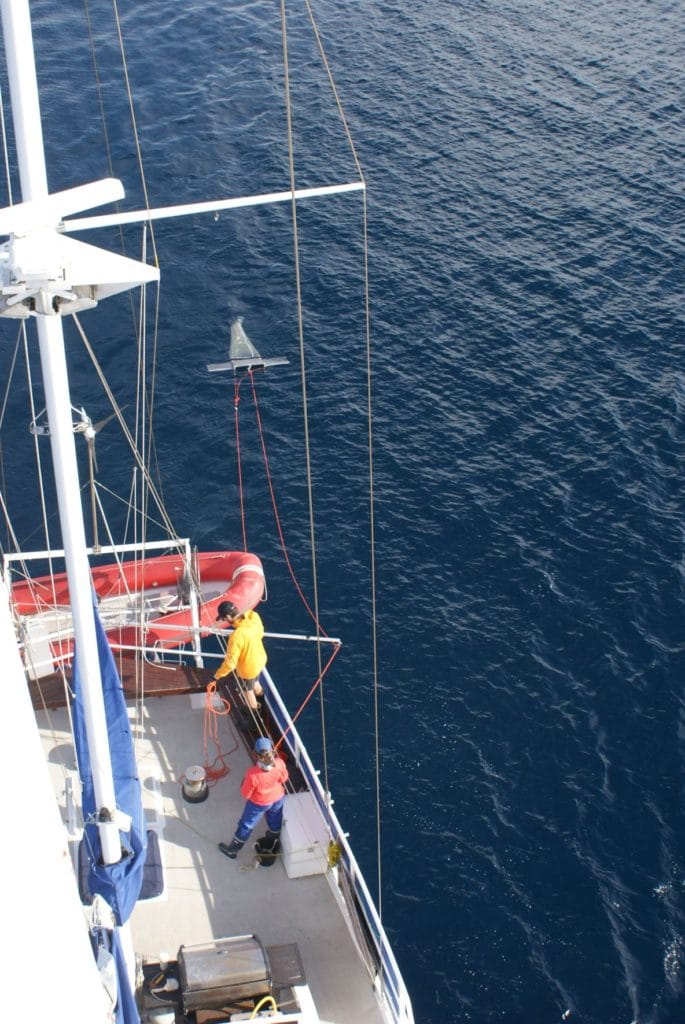
Birds eye view (from the mast) the manta trawl being deployed. 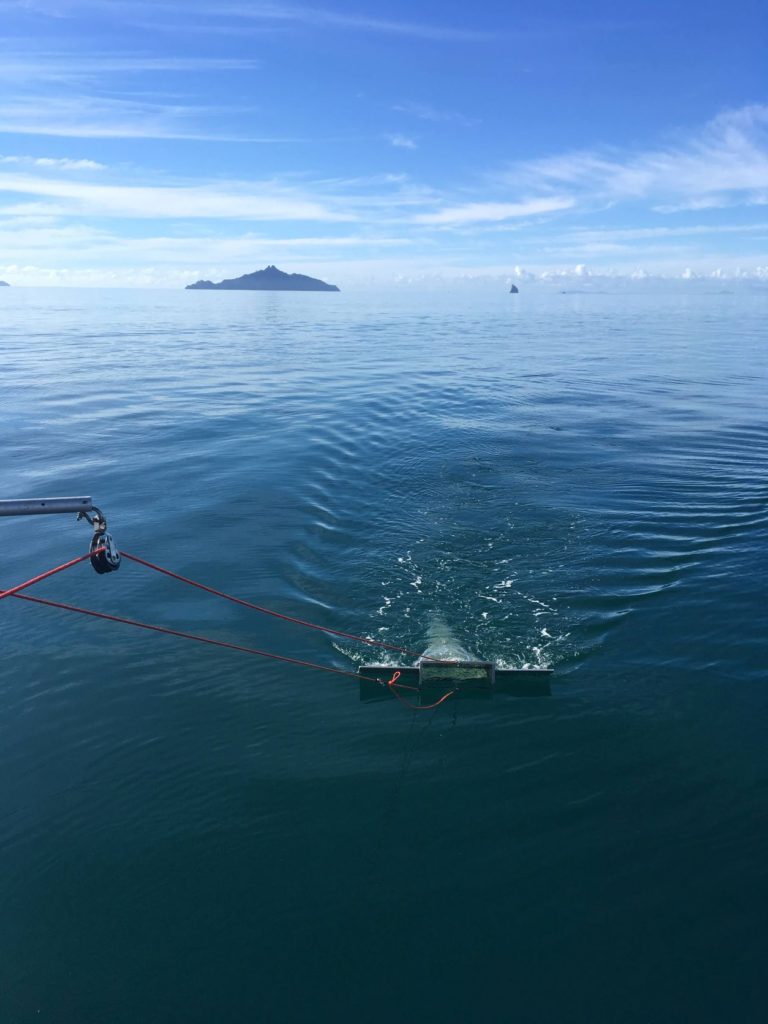
Manta trawl in action, photo taken before it moves further away from the boat. 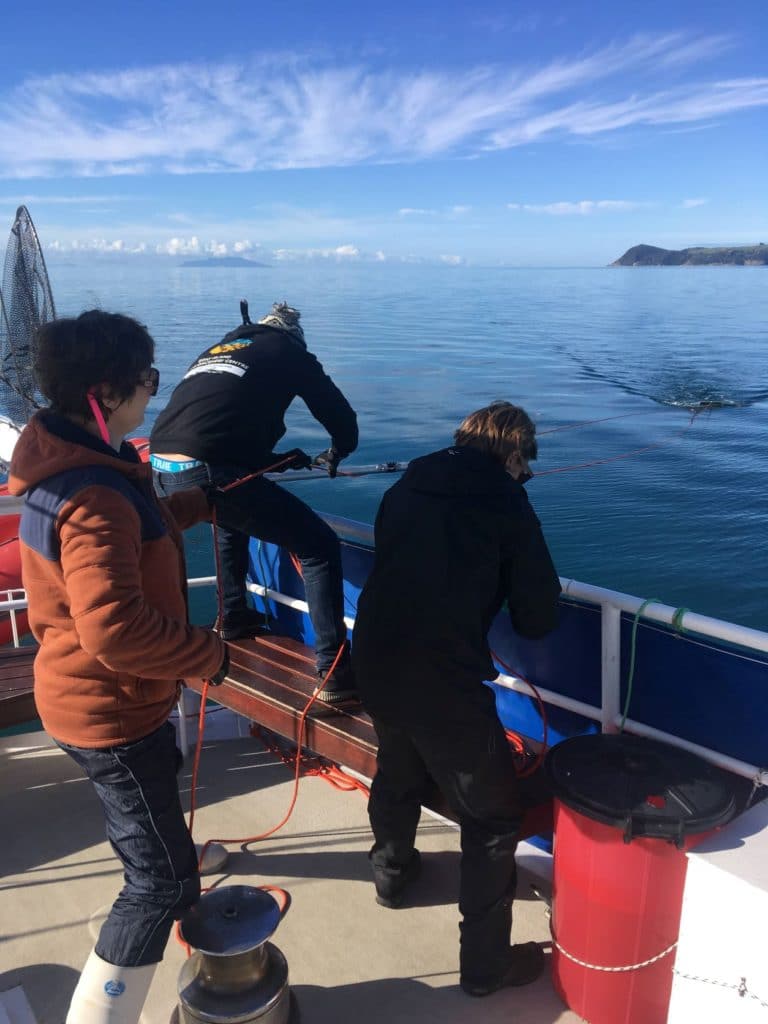
Manta trawl is retrieved by hand, usually by a team of 3.
Over the course of the day I got to help with all aspects of sampling – from data recording to packing away samples. It was a real pleasure working with Raquelle, Hayden and Emma, who are the microplastic researchers that ‘showed me the ropes’ so I could help out with collecting this data. I learned so much and saw some really little critters I’ve never seen before. In more than one sample we found these adorable crab postlarvae, also referred to as megalopa, which are in the transition stage between the zoea and growing up to be a baby crab. We also found lots of amphipods and occasionally some tiny fish! I’ll bet some of these plankton samples would be really interesting to look at under the microscope and I’m interested to hear about what the team that processed the samples has found.
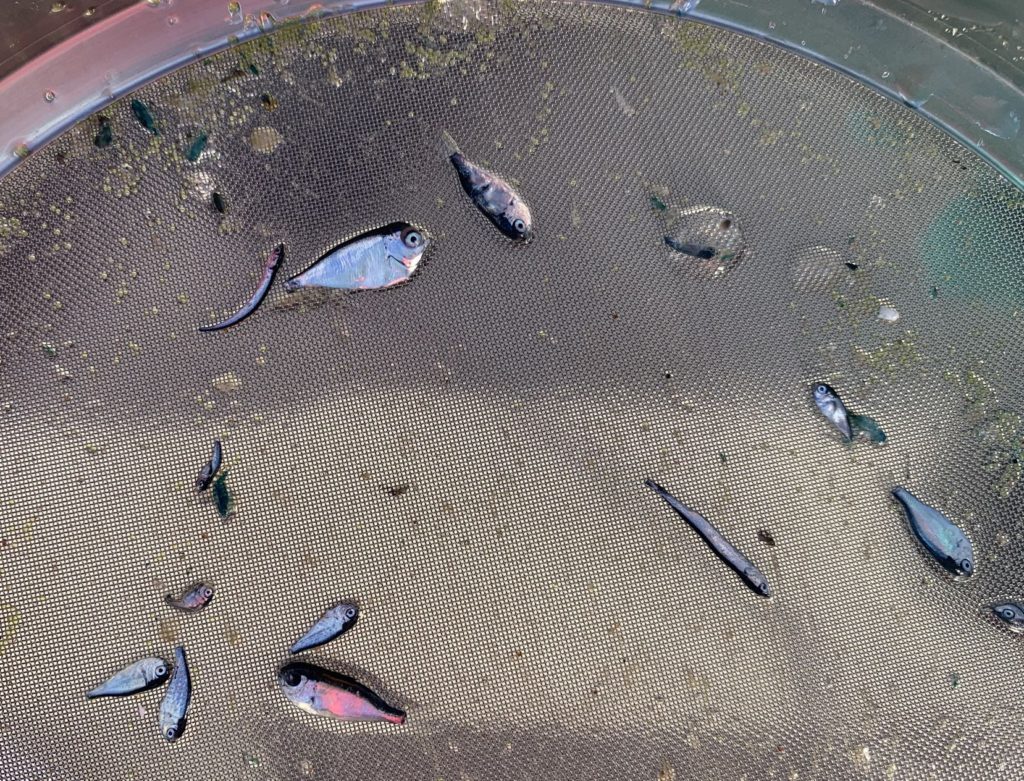
Variety of small fish. Photo Credit: Blue Cradle 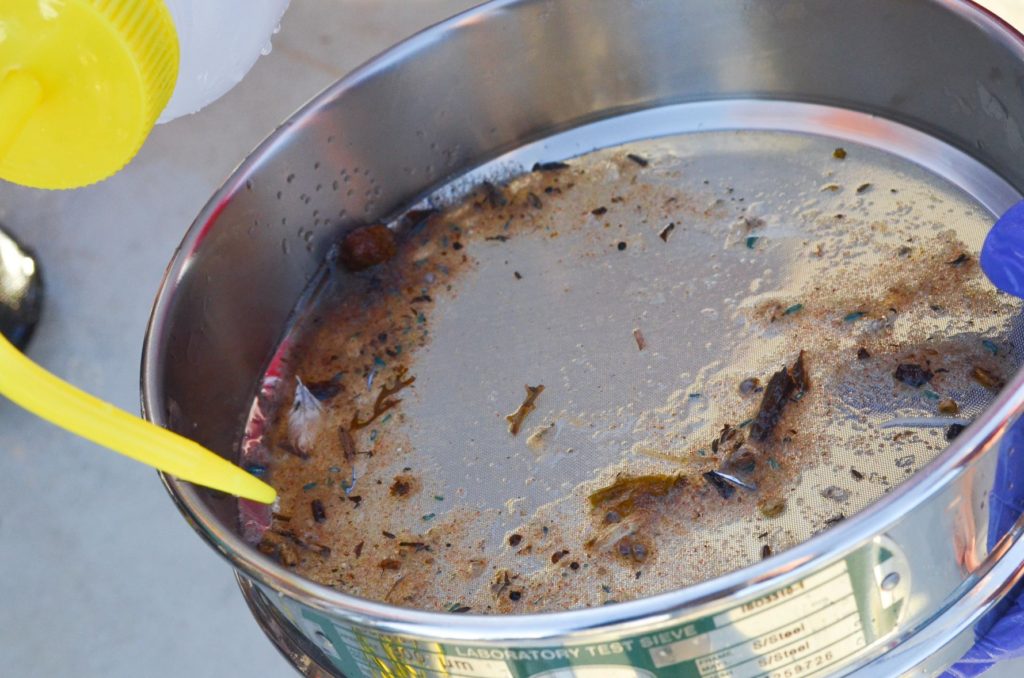
Photo Credit: Blue Cradle 
Crab megalopa
We had a stunningly flat and glassy ocean that day and so we collected lots of samples in those optimal conditions. It stayed so calm into the afternoon that we took a minute to have a real close-up look at Sail Rock and a few of us took the opportunity to go up the mast, just past the first spreader. It was actually my first time going up a mast, and I loved it. I’ve actually always wanted to go up a mast but this was the first boat I’ve spent time on which has rungs for you to climb up to the ‘crows nest’ so no one needs to winch you up there!
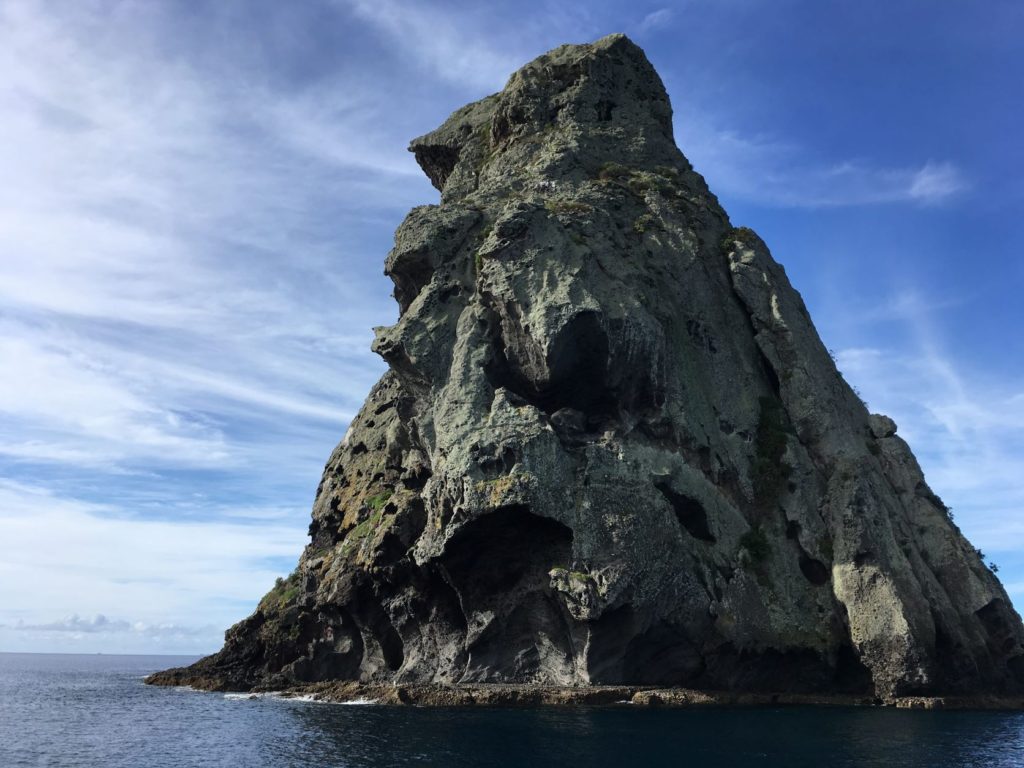
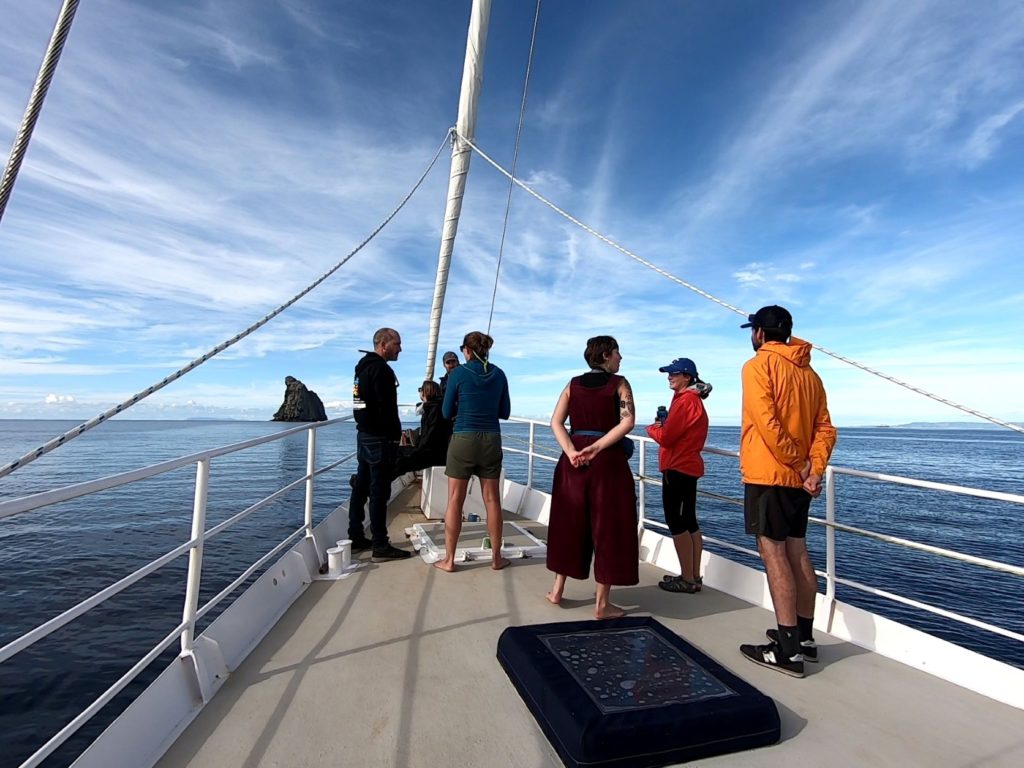
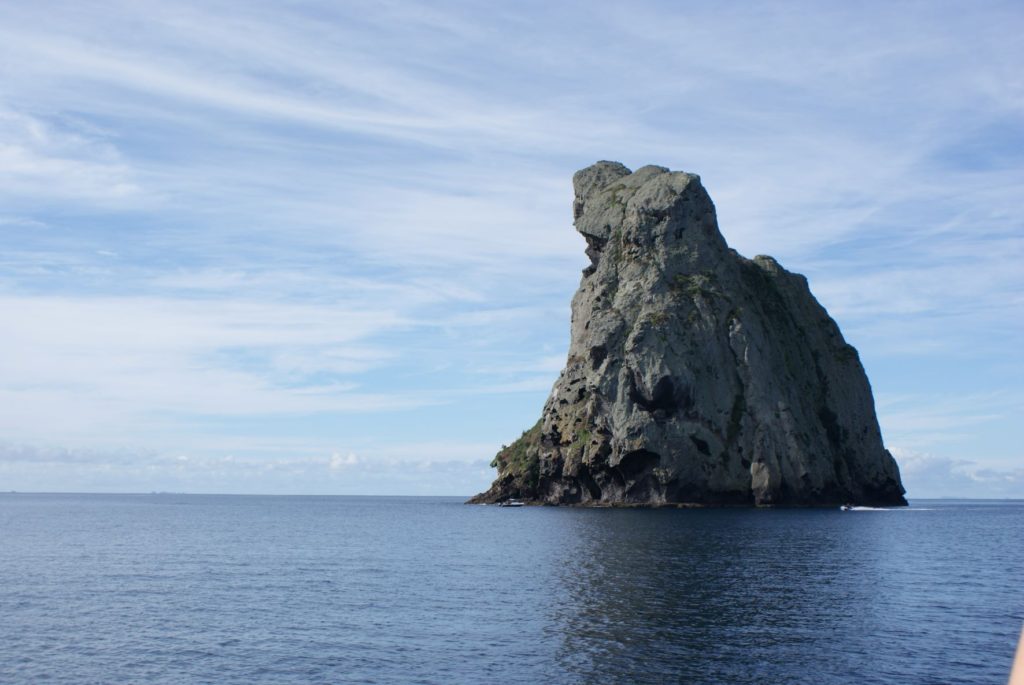
Sail Rock 
Data recording. Photo Credit: Blue Cradle 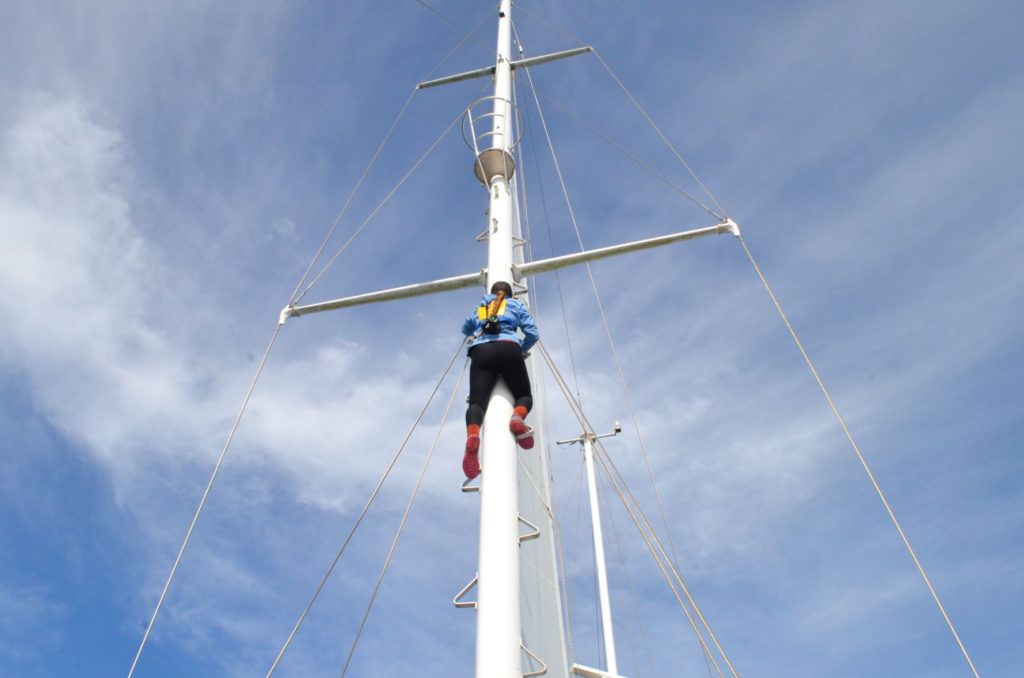
Climbing the mast. Photo Credit: Blue Cradle 
Photo from in the ‘Crows Nest’
We got to Marsden point sometime after dark and anchored up, had dinner and picked up 2 guests from the shore via tender. Then it was time to chill, so that evening I got into reading a borrowed book called Bluewater Gold Rush, and I almost couldn’t put it down – I was really intrigued, no book I’ve ever started before starts with a shark attack! Sometime around 11 pm I eventually turned my little light off and tried to fall asleep as I listened to the gusts get stronger and stronger and tried to ignore the haliard slapping against the mast.
Day 2: Marsden Cove
I spent over an hour tossing and turning until it was sometime after midnight and I still couldn’t really fall asleep. I now had this pretty irrational fear I was going to roll out of the narrow top bunk – even though the boat wasn’t rocking that much at all, we were moving a bit but just swinging on the anchor chain not leaning! I think I just freaked myself out because at some point when I was drifting off, I has this strange visualization of myself falling out of the bunk – then I awoke with a jolt. I slept fine the night before but after that strange ‘dream’ that night I was wide awake listening to the storm. Instead of lying there not sleeping, I tiptoed up to the pilot house stepping around the squeaky spots on the floor, and peered outside just to see what it was looking like – I really couldn’t tell if we had moved because we anchored after dark and I hadn’t been paying attention to where exactly we were in relation to the other boats.
Soon, I went back downstairs, pulled my sleeping bag down off the top bunk and moved myself into the saloon. I put the sleeping bag on the squabs (which is what we call the seat cushions on boats) and I tried to fall asleep there. I switched positions 3 times looking for the comfiest spot but to no avail, the squabs weren’t as squishy as the mattress, so not great for sleeping on your side. So, I was just lying there with my eyes closed sometime around 1 am when I heard the captain, soon after followed by his crew, rushing past, up the stairs to the helm – we were dragging. I stayed in the saloon and listened to them bring the anchor up and re-anchor, but it didn’t hold. So the anchor came up once or twice more before we motored over to a new spot. At this point I moved out of the saloon and back to the bunk room. The captain and crew had it all under control and re-anchored us somewhere safe, and while the engine was running I fell asleep in my bunk.
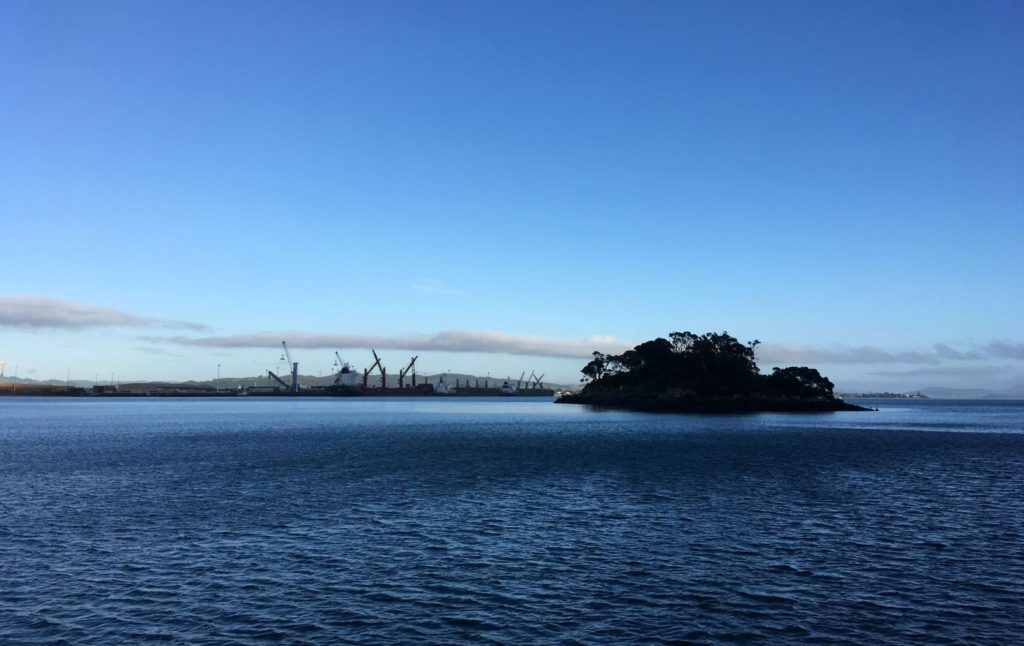
When I woke up again around 6 am it sounded quite calm – what a contrast to the overnight conditions! When I got outside I was shocked by the sunny blue skies, it was going to be another lovely day. Our new anchorage was opposite the Marsden Cover Refinery Plant, a totally different scene from where we first anchored. The night before we put the anchor down at a bay closer to Marsden Point, we were much further in the harbour now and it was much calmer. Everyone had some breakfast and we talked about the nights events then got into some sampling.
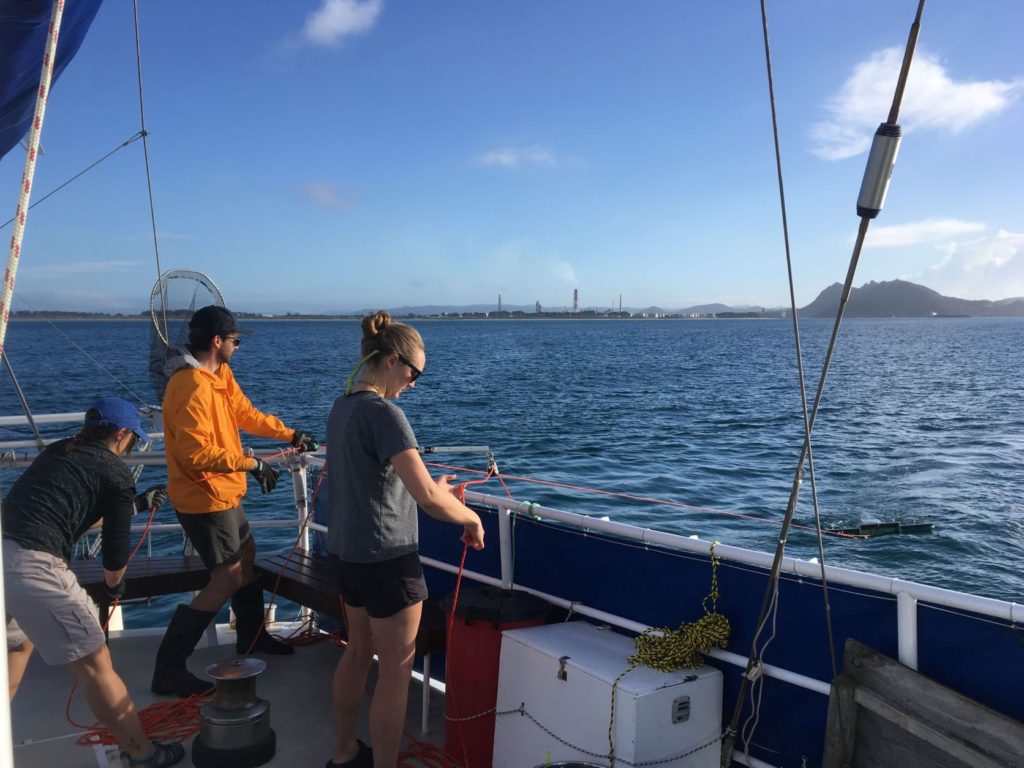
Sampling opposite the Marsden Cove Refinery 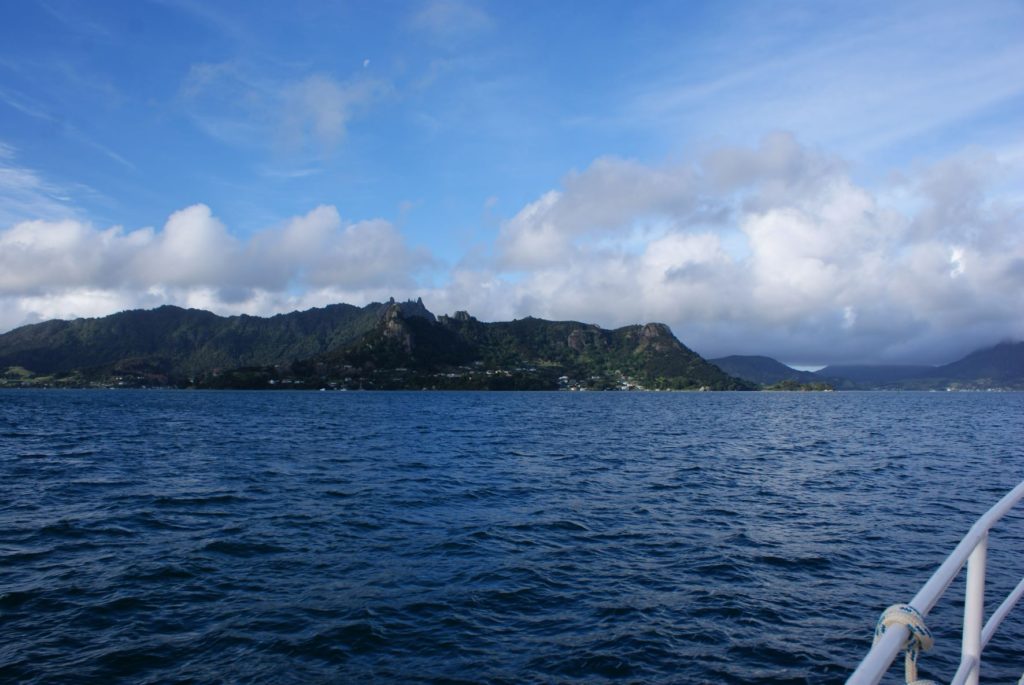
Whangarei Heads
The yacht couldn’t go very far up the harbour as it was pretty shallow so part of the team went out in the tender and did a trawl further up into the estuary. When they came back, after everyone had lunch, there was enough time for a group swim – it was refreshingly cold and very fun! Eventually we made our way into to Marsden Cove Marina and had a lovely evening tied up to the pontoon with about a hundred (noisy) resident seagulls as our neighbors.
Day 3: Marsden Cove Marina
For most of the team and crew this was their opportunity to be back on land for a little while after 9 days with hardly any break. Some had to do some laundry, catch up on emails, prepare presentations for the workshop the following day, etc. However for me it was quite a low key day, very slow paced and chill compared to the days before! A bunch of us went for a walk down to the community market and got some fresh fruits and lovely sourdough bread while some enjoyed barista coffee and pastries. It was a very relaxed day, when I checked in with a few others I realised the strange feeling of not having much ‘work’ to do was shared. I didn’t bring any running gear but had some time to kill and wanted to stretch the legs so instead I walked down to the beach and inevitably collected a lot of rubbish – even found a piece of what looked like a very long lived plastic packaging of ‘Scooby snacks‘.
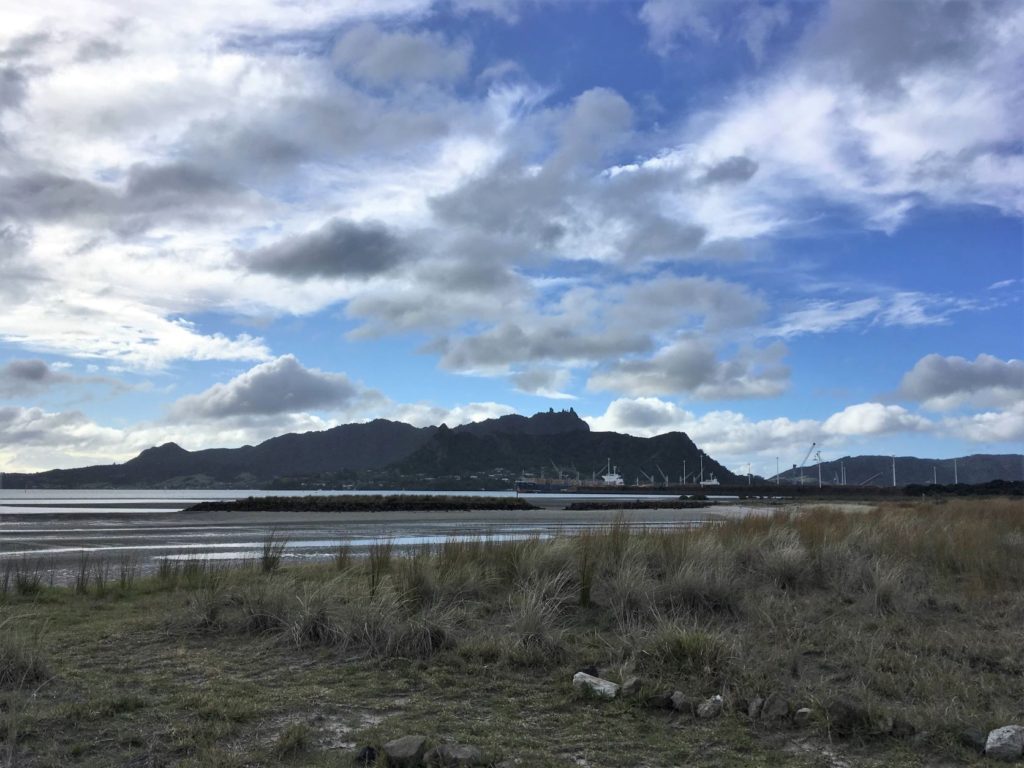
Beach between the Marsden Cove Marina and Refinery 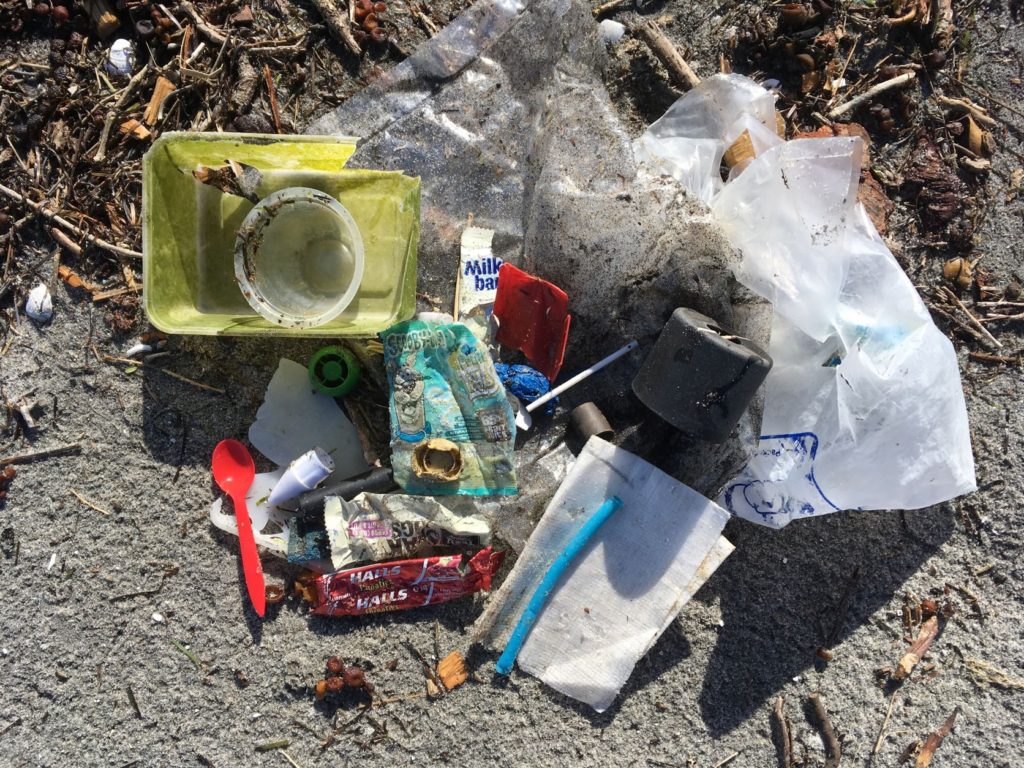
Just a portion of the rubbish I collected 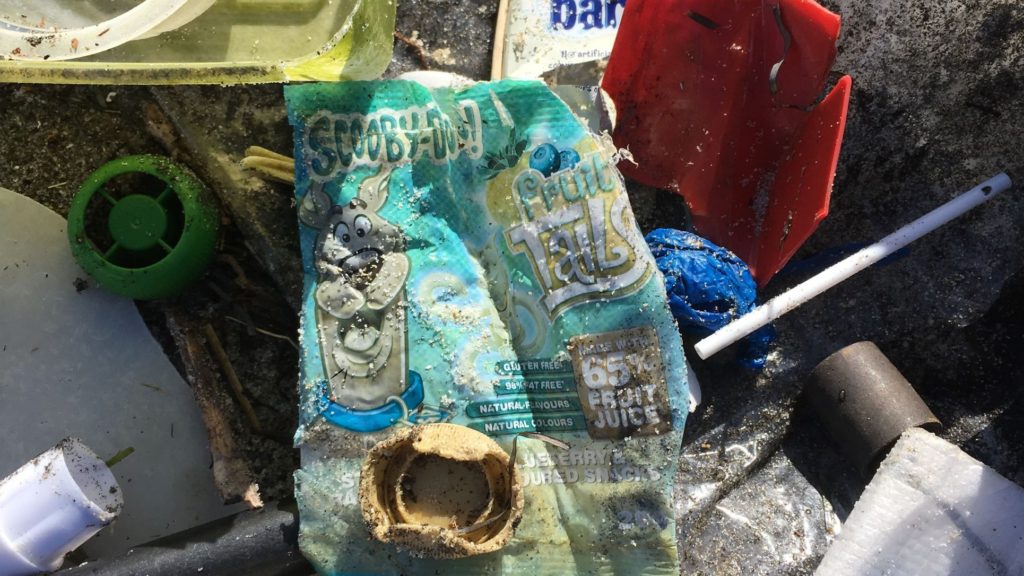
Scooby Snacks!
There was more than I could collect, I didn’t anticipate such a mess or I would have brought a bigger bag! I picked up a few bits that practically disintegrated in my hands and I thought about how long they might have been there – the UV rays breaking them down on the spot. I tried not to think about how many more beaches there were like this and what it would feel like being on ones which were far worse. Plastic pollution can be an overwhelming thing when you think about it a lot.
We didn’t do any sampling with the manta trawl that day but the biosecurity team was planning to do some sampling in the marina later that afternoon. So when I returned from the beach I resorted to reading my book – I’ll be honest that this ‘reading-for-pleasure thing’ doesn’t happen very much these days – I used to love to read all sorts of books just for fun but now I can’t seem to find the time for leisurely reading. However, when I am on a boat I do find that I let myself relax just a little bit.
When the tide was high, the Marine Biosecurity Toolbox team collected some samples to investigate the prevalence of non-indigenous, marine invasive species in the marina. There’s likely to be quite a few invasive species detected here, some more ‘invisible’ than others so this sampling relies on the Environmental DNA (eDNA and eRNA) in the marine environment which comes from the free-floating molecules, particulate matter, expelled cells or living propagules (eggs and larvae) which marine organisms constantly release. Environmental DNA represents the organisms’ blueprint in an ecosystem and is very helpful for detecting and identifying species. The team collected their samples with a vertical water column plankton net using two sampling methods, one for shallow and one for deep, for comparing the top two meters of the water column to the whole water column. Then they look at the eDNA sequences detected in each sample and infer presence and prevalence of unwanted (invasive) species in that environment!
This research is part of the journey to finding the easiest and most effective way to detect marine pests. Invasive species like mediterranean fanworm are aggressive bio-foulers and might displace native species (eg. oysters and mussels) but many of the effects of these invasives are unknown, so it is helpful to know where they are occuring so their impacts can be monitored or mitigated if possible. Transport and transfer of ballast water and biofouled boats are the main vectors of transport of marine invasive species and links into why the Clean Below? Good To Go campaign around maintaining clean boat hulls is significant. Keeping hulls clean is one major way Kiwis can take action to stop the spread of marine pests.

Marsden Cove Marina in the sunshine. 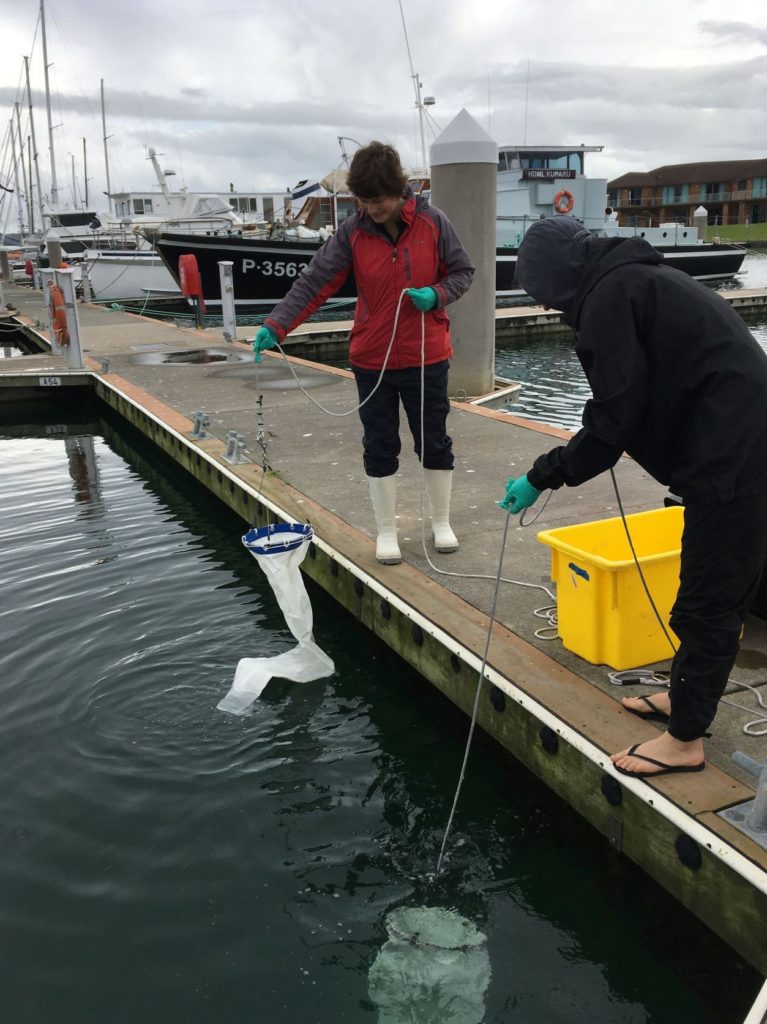
The vertical plankton nets in action. 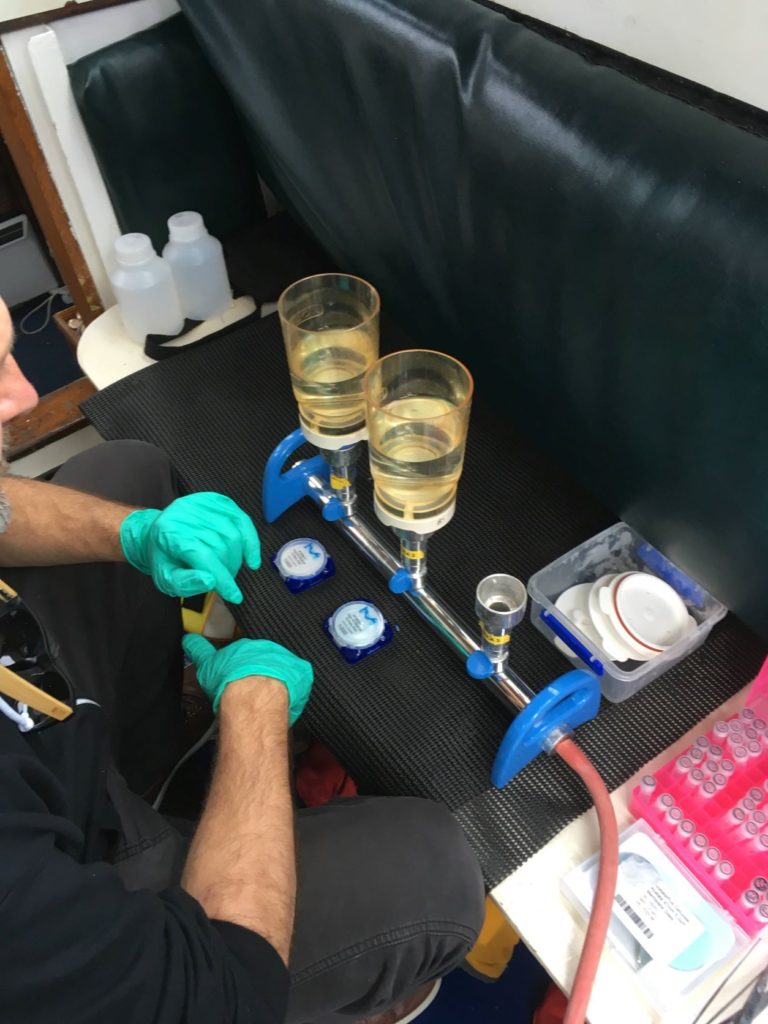
The filtration station onboard the yacht.
Day 4: Marine Biosecurity & Microplastics Workshop
After a quick breakfast we headed down to the Marsden Cove Yacht Club for a workshop organized by Northern Regional Council. It was an engaging day of learning and sharing for over 40 people from near and far – the expedition team, mana whenua, industry professionals, council and community members. The workshop started with covering some background information on plastic pollution and why this research on microplastics matters. Through hands on activities participants explored what microplastics actually look like, how they enter the environment and how plastics with various densities act (sink vs. float). Aside from the obvious ways that plastic enters the environment, it was highlighted that wastewater is a direct source of microplastics into the environment. It’s mind blowing when you think about the number of microfibres, filaments and fragments coming off of the clothing we wash and products we use are constantly breaking down and entering the environment.
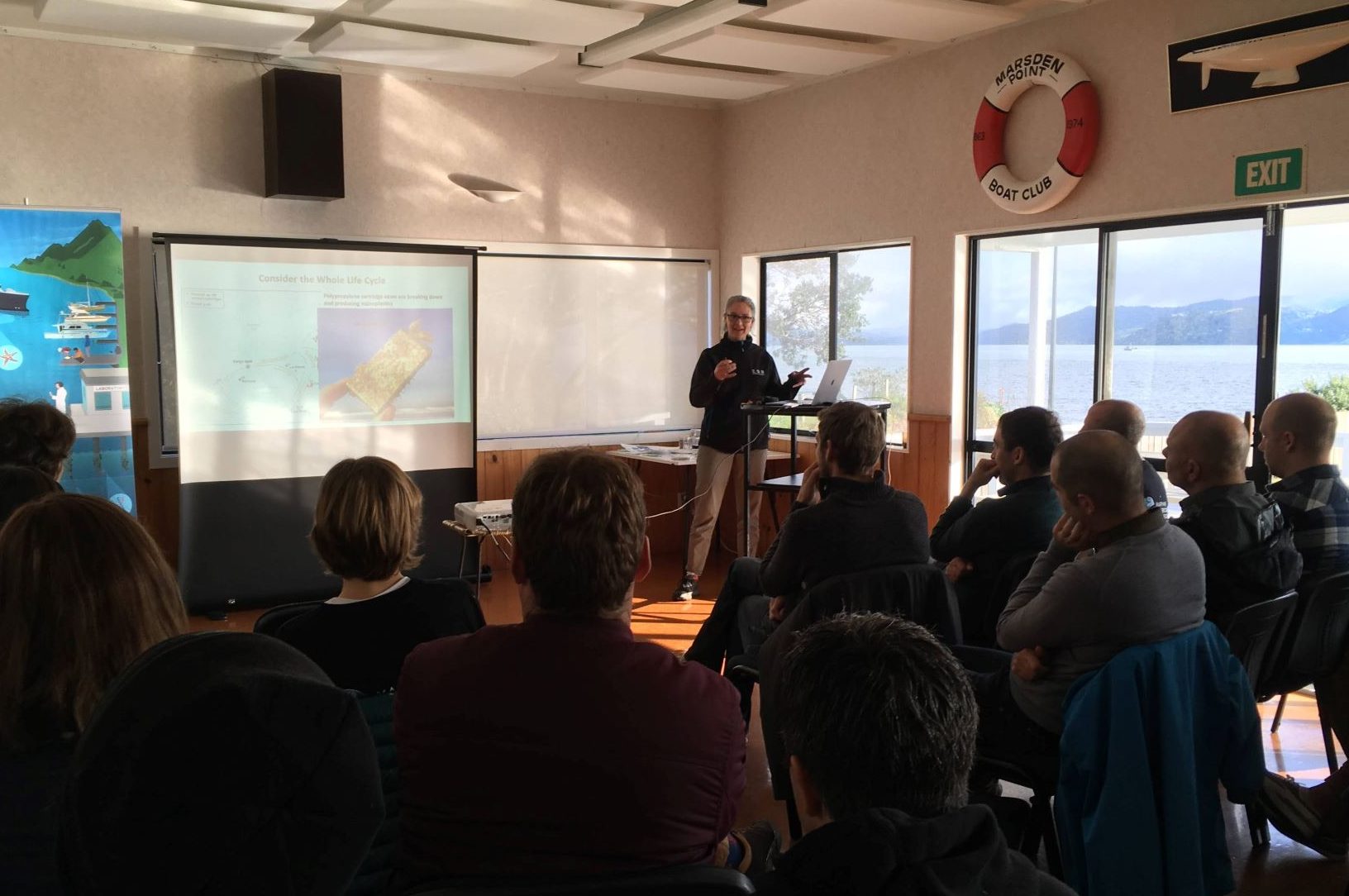
We learned a little about nanoplastics, which are plastics smaller than one micron, and while very difficult to study, it’s important that we learn more about the impact of nanoplastics. Recent research has revealed that these very small plastics can interact with and potentially pass through cell membranes! Dr. Olga Pantos also spoke about the various additives in plastics that leach into the environment and explained that the density of the plastic polymers which remain, can actually change over time, altering the behaviours of different plastics as they age. Leachates from these plastic products also enter the environment from landfill, which means additives from plastic can certainly be found in our soil and is actively being taken up by plants. There are so many additives to plastic which have negative interactions with microbes, not to mention the act that they are a biosecurity risk.
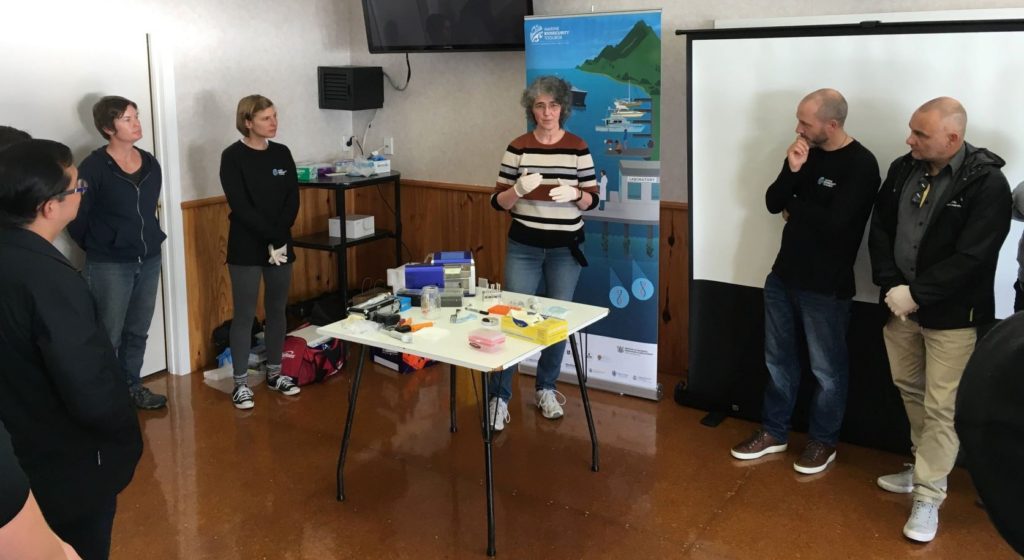
That segued nicely into presentations from the biosecurity team who highlighted the transformation of complex molecular tools demonstrating use of a ‘toaster-sized’ instrument for eDNA/eRNA extraction and a hand-held molecular assay for the Mediterranean fanworm detection that is enabling easier and more efficient detection of invasive species. Some participated and others observed the process of eDNA and eRNA isolation and running the field-based molecular assay! The workshop was wrapped up with some great group discussions about what next steps could look like to help share this knowledge and potentially use the biosecurity toolbox in the local area.
Conclusion
I am grateful for the opportunity I had to expand my network and learn different methods used in other areas of research. I came away inspired by the many passionate individuals and groups of scientists I met that are concerned about the various interactions with respect to biosecurity and plastic pollution. It got me interested in doing deeper investigations about the way plastic is interacting with our environment, how it affects us and the various creatures that ingest it.
This expedition was a great experience for me, an inspiring time and also a reminder of how important it is to be flexible. Trips like these require last minute changes, alterations due to weather systems, and adjusting plans to accommodate that many people. It was really awesome to see the level of collaboration that was carried out all throughout this and I am so grateful that the team was very friendly and inclusive. There was always great positive vibes on board and it was so cool that this expedition incorporated public engagement and participation in workshops along the way. After, I departed that Monday evening after the workshop the Blue Cradle team had a few more days sailing further north up the coast, stopping at the Poor Knights Islands and then continuing onto Bay of Islands, then going back to their respective homes until the next expedition. You can find out more about the people and partners involved in this expedition on the Blue Cradle website.

